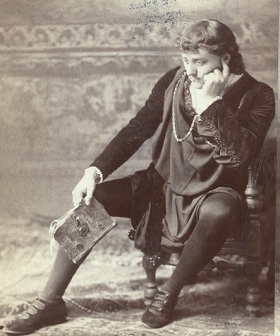Hamlet's Soliloquy: To be, or not to be: that is the question (3.1)
Commentary
Unlike Hamlet's first two major soliloquies, his third and most famous speech seems to be governed by reason and not frenzied emotion. Unable to do little but wait for completion of his plan to "catch the conscience of the king", Hamlet sparks an internal philosophical debate on the advantages and disadvantages of existence, and whether it is one's right to end his or her own life. Some scholars limit Hamlet's discussion to a deliberation of whether he should take his own life. "Yet nothing anywhere in the speech relates it to Hamlet's individual case. He uses the pronouns we and us, the indefinite who, the impersonal infinitive. He speaks explicitly of us all, of what flesh is heir to, of what we suffer at the hands of time or fortune - which serves incidentally to indicate what for Hamlet is meant by to be" (Jenkins 489).
Hamlet asks the question for all dejected souls -- is it nobler to live miserably or to end one's sorrows with a single stroke? He knows that the answer would be undoubtedly yes if death were like a dreamless sleep. The rub or obstacle Hamlet faces is the fear of what dreams may come (74), i.e. the dread of something after death (86). Hamlet is well aware that suicide is condemned by the church as a mortal sin.
Hamlet's soliloquy is interrupted by Ophelia who is saying her prayers. Hamlet addresses her as Nymph, a courtly salutation common in the Renaissance1. Some critics argue that Hamlet's greeting is strained and coolly polite, and his request that she remembers him in her prayers is sarcastic. However, others claim that Hamlet, emerging from his moment of intense personal reflection, genuinely implores the gentle and innocent Ophelia to pray for him.
It is fascinating to compare Shakespeare's finished masterpiece to the version found in the First Quarto (or Q1) published by Nicholas Ling and John Trundell in 1603:
To be, or not to be, I there's the point.
To Die, to sleepe, is that all ? I all:
No, to sleepe, to dreame, I mary there is goes,
For in that dreame of death, when we awake,
And borne before an everlasting Judge,
From whence no passenger ever returned,
The undiscovered country, at whose sight
The happy smile, and the accursed damn'd,
But for this, the joyfull hope of this,
Whol'd beare the scornes and flattery of the world,
Scorned by the right rich, the rich curssed of the poore?
The widow being oppressed, the orphan wrong'd,
The taste of hunger, or a tirants raigne.
And thousand more calamities besides
To grunt and sweate under this weary life,
When that he may his full Quietus make,
With a bare bodkin, who would this indure,
But for a hope of something after death?
Which pusles the braine, and doth confound the sence,
Which makes us rather beare those evilles we have,
Than flie to others that we know not of.
I, that, O this conscience makes cowards of us all.
Q1 was likely a product of the memories of actors who had staged Hamlet and, in 1604, a new version appeared (Q2), based on Shakespeare's own manuscript, complete with the soliloquy as we know it.
For an absolutely remarkable interpretation of Hamlet's soliloquy, please watch the BBC production starring Sir Derek Jacobi, available in its entirety from the BBC on YouTube. You can find it at 1:25:30.
Back to Soliloquy Annotations
Notes
1. See also A Midsummer Night's Dream 2.1.245, 4.1.132; Two Gentlemen of Verona 5.4.12.
How to cite this article:
Mabillard, Amanda. Hamlet's Soliloquy Analysis. Shakespeare Online. 20 Aug. 2000. < http://shakespeare-online.com/plays/hamlet/soliloquies/tobeanalysis.html >.
Reference
Shakespeare, William. Hamlet. Ed. Harold Jenkins. London: Methuen, 1982.
___________
Even More...
 Hamlet's Silence Hamlet's Silence
 An Excuse for Doing Nothing: Hamlet's Delay An Excuse for Doing Nothing: Hamlet's Delay
 Foul Deeds Will Rise: Hamlet and Divine Justice Foul Deeds Will Rise: Hamlet and Divine Justice
 Defending Claudius - The Charges Against the King Defending Claudius - The Charges Against the King
 Shakespeare's Fools: The Grave-Diggers in Hamlet Shakespeare's Fools: The Grave-Diggers in Hamlet
 Hamlet's Humor: The Wit of Shakespeare's Prince of Denmark Hamlet's Humor: The Wit of Shakespeare's Prince of Denmark
 All About Yorick All About Yorick
 Hamlet's Melancholy: The Transformation of the Prince Hamlet's Melancholy: The Transformation of the Prince
 Hamlet's Antic Disposition: Is Hamlet's Madness Real? Hamlet's Antic Disposition: Is Hamlet's Madness Real?
 The Significance of the Ghost in Armor The Significance of the Ghost in Armor
 The Significance of Ophelia's Flowers The Significance of Ophelia's Flowers
 Ophelia and Laertes Ophelia and Laertes
 Mistrusted Love: Ophelia and Polonius Mistrusted Love: Ophelia and Polonius
 Divine Providence in Hamlet Divine Providence in Hamlet
 What is Tragic Irony? What is Tragic Irony?
 Seneca's Tragedies and the Elizabethan Drama Seneca's Tragedies and the Elizabethan Drama
 Shakespeare's Sources for Hamlet Shakespeare's Sources for Hamlet
 Characteristics of Elizabethan Tragedy Characteristics of Elizabethan Tragedy
 Why Shakespeare is so Important Why Shakespeare is so Important
 Shakespeare's Language Shakespeare's Language
 Shakespeare's Influence on Other Writers Shakespeare's Influence on Other Writers
 Daily Life in Shakespeare's London Daily Life in Shakespeare's London
 Life in Stratford (structures and guilds) Life in Stratford (structures and guilds)
 Life in Stratford (trades, laws, furniture, hygiene) Life in Stratford (trades, laws, furniture, hygiene)
 Stratford School Days: What Did Shakespeare Read? Stratford School Days: What Did Shakespeare Read?
 Games in Shakespeare's England [A-L] Games in Shakespeare's England [A-L]
 Games in Shakespeare's England [M-Z] Games in Shakespeare's England [M-Z]
 An Elizabethan Christmas An Elizabethan Christmas
 Clothing in Elizabethan England Clothing in Elizabethan England
 Queen Elizabeth: Shakespeare's Patron Queen Elizabeth: Shakespeare's Patron
 King James I of England: Shakespeare's Patron King James I of England: Shakespeare's Patron
 The Earl of Southampton: Shakespeare's Patron The Earl of Southampton: Shakespeare's Patron
 Going to a Play in Elizabethan London Going to a Play in Elizabethan London
 Ben Jonson and the Decline of the Drama Ben Jonson and the Decline of the Drama
 Publishing in Elizabethan England Publishing in Elizabethan England
 Shakespeare's Audience Shakespeare's Audience
 Religion in Shakespeare's England Religion in Shakespeare's England
 Alchemy and Astrology in Shakespeare's Day Alchemy and Astrology in Shakespeare's Day
 Entertainment in Elizabethan England Entertainment in Elizabethan England
 London's First Public Playhouse London's First Public Playhouse
 Shakespeare Hits the Big Time Shakespeare Hits the Big Time
|

Points to Ponder
 In his book Shakespearean Tragedy, A. C. Bradey notes that "The present position of the 'To be or not to be' soliloquy, and of the interview with Ophelia, appears to have been due to an after-thought of Shakespeare's; for in the First Quarto they precede, instead of following, the arrival of the players, and consequently the arrangement for the play-scene. This is a notable instance of the truth that 'inspiration' is by no means confined to a poet's first conceptions." Does the position of Hamlet's soliloquy make a difference? More on this subject...
In his book Shakespearean Tragedy, A. C. Bradey notes that "The present position of the 'To be or not to be' soliloquy, and of the interview with Ophelia, appears to have been due to an after-thought of Shakespeare's; for in the First Quarto they precede, instead of following, the arrival of the players, and consequently the arrangement for the play-scene. This is a notable instance of the truth that 'inspiration' is by no means confined to a poet's first conceptions." Does the position of Hamlet's soliloquy make a difference? More on this subject...
|
More to Explore
 Hamlet: The Complete Play with Explanatory Notes Hamlet: The Complete Play with Explanatory Notes
 Extensive Analysis of Act 2, Scene 2 Extensive Analysis of Act 2, Scene 2
 The Hamlet and Ophelia Subplot The Hamlet and Ophelia Subplot
 The Norway Subplot in Hamlet The Norway Subplot in Hamlet
 Hamlet Basics Hamlet Basics
 Hamlet: Plot Summary with Key Passages Hamlet: Plot Summary with Key Passages
 Analysis of the Characters in Hamlet Analysis of the Characters in Hamlet
 Deception in Hamlet Deception in Hamlet
 Problem Plays and Revenge Tragedy Problem Plays and Revenge Tragedy
_____
|
Shakespeare and Montaigne ... In writing Hamlet, Shakespeare is said to have been influenced by the work of French essayist, Michael de Montaigne, translated by an acquaintance of Shakespeare named John Florio. Montagine's essays on moral philosophy might have shaped many passages in Hamlet, including Hamlet's most famous soliloquy. Could Montaigne be the reason the first and second quartos of the play are so different, especially regarding Hamlet's propensity to delay? Read more about Shakespeare, Montaigne and Hamlet.
|
_____
 The Purpose of The Murder of Gonzago The Purpose of The Murder of Gonzago
 The Dumb-Show: Why Hamlet Reveals his Knowledge to Claudius The Dumb-Show: Why Hamlet Reveals his Knowledge to Claudius
 Hamlet's Relationship with the Ghost Hamlet's Relationship with the Ghost
 Philological Examination Questions on Hamlet Philological Examination Questions on Hamlet
 Quotations from Hamlet (with commentary) Quotations from Hamlet (with commentary)
 Hamlet Study Quiz (with detailed answers) Hamlet Study Quiz (with detailed answers)
 Analysis of I am sick at heart (1.1) Analysis of I am sick at heart (1.1)
 Analysis of What a piece of work is a man! (2.2) Analysis of What a piece of work is a man! (2.2)
 Hamlet: Q & A Hamlet: Q & A
 Soliloquy Analysis: O this too too... (1.2) Soliloquy Analysis: O this too too... (1.2)
 Soliloquy Analysis: O, what a rogue and peasant slave am I!... (2.2) Soliloquy Analysis: O, what a rogue and peasant slave am I!... (2.2)
 Soliloquy
Analysis: To be, or not to be... (3.1) Soliloquy
Analysis: To be, or not to be... (3.1)
 Soliloquy Analysis: Tis now the very witching time of night... (3.2) Soliloquy Analysis: Tis now the very witching time of night... (3.2)
 Soliloquy Analysis: Now might I do it pat... (3.3) Soliloquy Analysis: Now might I do it pat... (3.3)
 Soliloquy Analysis: How all occasions do inform against me... (4.4) Soliloquy Analysis: How all occasions do inform against me... (4.4)
 Ophelia's Burial and Christian Rituals Ophelia's Burial and Christian Rituals
 The Baker's Daughter: Ophelia's Nursery Rhymes The Baker's Daughter: Ophelia's Nursery Rhymes
 Hamlet as National Hero Hamlet as National Hero
 The Elder Hamlet: The Kingship of Hamlet's Father The Elder Hamlet: The Kingship of Hamlet's Father
 Claudius and the Condition of Denmark Claudius and the Condition of Denmark
 In Secret Conference: The Meeting Between Claudius and Laertes In Secret Conference: The Meeting Between Claudius and Laertes
 O Jephthah - Toying with Polonius O Jephthah - Toying with Polonius
 The Death of Polonius and its Impact on Hamlet's Character The Death of Polonius and its Impact on Hamlet's Character
 Blank Verse and Diction in Shakespeare's Hamlet Blank Verse and Diction in Shakespeare's Hamlet
|

 In his book Shakespearean Tragedy, A. C. Bradey notes that "The present position of the 'To be or not to be' soliloquy, and of the interview with Ophelia, appears to have been due to an after-thought of Shakespeare's; for in the First Quarto they precede, instead of following, the arrival of the players, and consequently the arrangement for the play-scene. This is a notable instance of the truth that 'inspiration' is by no means confined to a poet's first conceptions." Does the position of Hamlet's soliloquy make a difference?
In his book Shakespearean Tragedy, A. C. Bradey notes that "The present position of the 'To be or not to be' soliloquy, and of the interview with Ophelia, appears to have been due to an after-thought of Shakespeare's; for in the First Quarto they precede, instead of following, the arrival of the players, and consequently the arrangement for the play-scene. This is a notable instance of the truth that 'inspiration' is by no means confined to a poet's first conceptions." Does the position of Hamlet's soliloquy make a difference?